Changes in your skin’s tone, texture, and complexion are inevitable with age. Fine lines, creases, and wrinkles form around your eyes, nose, and mouth. Discoloration, evidence of sun damage, and sagging skin all become more noticeable as UV rays, gravity, stress, and environmental factors take their toll. The good thing is that non-surgical face rejuvenation can easily treat these issues.
So what is non-surgical facial rejuvenation? These are procedures wherein patients don’t need to go under the knife to refresh their appearance. Chemical peels, laser treatments, microdermabrasion, and injectable products like Botox or dermal fillers can restore a more youthful complexion with no incisions, scarring, or recovery time needed.
What Are Your Options for Non-Surgical Facial Rejuvenation?
Non-surgical facial rejuvenation procedures can help you enhance your beauty in a safe, quick, and painless way. You would be an ideal candidate for these treatments if your goals are to:
- Add volume to “sunken” areas
- Minimize fine lines, folds, and wrinkles
- Erase scars, dark spots, and other blemishes
- Reduce blotchiness and redness
- Improve overall tone and texture of the skin
These exciting techniques are fairly new changes in the medical field of cosmetic surgery, but they’ve quickly been adopted as a good way to tweak appearances in a not-so-obvious way. Most patients also appreciate the fact that they can improve their looks without incisions, anesthesia, scarring, and other risks related to surgery. Some of the most beloved methods of non-surgical facial rejuvenation include:
Botox and Dysport
As people grow older, dynamic wrinkles appear more and more. Dynamic wrinkles are the fine lines and creases which form as a result of repeated facial movements like frowning, squinting, or smiling. Common dynamic wrinkles include forehead creases, crow’s feet, and the ‘11s’ found between the eyebrows.
Botulinum type A injectables are the first (and eternally popular) non-surgical treatment for dynamic wrinkles. Better known by their brand names Botox and Dysport, millions of these FDA-approved neurotoxin injections are administered in the US yearly. What botulinum neurotoxin products do is to temporarily paralyze facial muscles associated with dynamic wrinkles. Once the muscles are relaxed, patients can enjoy smoother and younger-looking faces. Unless your cosmetic surgeon lacks expertise, the risk of droopy eyelid and stiff facial muscles is low.
Aside from addressing wrinkles, Botox and similar products can also relieve migraine headaches, reduce excessive sweating, and minimize muscle spasms in the neck and eyes. Botox injections may even help relax “gummy” smiles with a few injections to the levator labii superioris muscle.
Dermal Fillers
Human faces lose volume as we age, especially when the collagen in our skin decreases due to wear and tear. Loss of collagen creates a hollow, sunken look for the face and makes people look visibly older. Dermal or soft tissue fillers are injectable products which can increase volume in the nasolabial folds, marionette lines, and other major wrinkles.
Dermal fillers like Juvederm, Restylane, Radiesse, Sculptra, and Belotero can remedy the loss of fullness around the eyes, mouth, jawline, nose, brow, and cheeks. Certain types of soft tissue fillers can also be injected to treat wrinkles and to plump up thin lips. Most cosmetic surgeons favor fillers made of:
- Hyaluronic acid (HA): The soft and gel-like hyaluronic acid filler is made up of a compound similar to a natural substance in our body. HA fillers can add volume to the face and keep the skin hydrated for 6 – 12 months.
- Poly-L-lactic acid: Poly-L-lactic acid is a biodegradable, biocompatible, synthetic substance, usually found in medical devices like dissolvable stitches. Poly-L-lactic acid fillers serve as collagen stimulators for up to 2 years, making them ideal for areas with severe volume loss.
- Calcium Hydroxylapatite (CaHA): CaHA is a naturally occurring substance found in our bonds. As a filler, the microscopic CaHA particles are suspended in a thick, smooth gel which lasts for 12 months. It can stimulate natural collagen production in deeper lines and folds.
Laser Resurfacing and IPL
Are you tired of having an uneven skin tone? Do you want to reduce the appearance of wrinkles, age spots, scars, blood vessels, sun damage, and other blemishes? If so, light therapy is for you.
The first type of light therapy is laser resurfacing, where highly concentrated beams of light energy are directed at the skin to improve its tone, texture, and appearance. There are two types of lasers used for resurfacing: ablative and non-ablative. Ablative lasers remove the outer layer of skin so that new skin can heal in its place. On the other hand, non-ablative lasers heat up below the skin’s surface to promote the growth of fresh collagen.
The second type of light therapy is intense pulsed light (IPL), which is also marketed as photofacial, photo rejuvenation, or broad band light (BBL). Unlike the highly focused, singular wavelength of lasers, IPL therapy delivers short pulses of light with a broad spectrum of wavelengths.
Both laser resurfacing and IPL procedures can treat hyperpigmentation and skin tone issues. Depending on the skill of your provider, light therapies can address:
- Fine lines and wrinkles
- Redness, rosacea, brown spots, or discoloration
- Loose or saggy skin
- Age spots, sun damage, or freckles
- Acne or surgical scars
- Spider veins and vascular lesions
- Unwanted facial hair
Chemical Peel
The smooth and clear complexion we were born with tends to grow ruined with age. Acne, stress, sun exposure, lack of sleep, and even lifestyle factors such as smoking or drinking alcohol can make the skin look blotchy, uneven, and wrinkly. Chemical peels can greatly reduce signs of aging.
A chemical peel is a solution that can slough off and peel away dead skin, allowing smoother skin to regenerate in its place. When applied to the face, chemical peels can remove the upper layers of the epidermis by dissolving skin cells. This allows chemical peels to treat wrinkles, age spots, superficial scarring, discoloration, keratosis, and precancerous skin growths. Common chemical peel solutions include:
- Glycolic acid
- Salicylic acid
- Trichloroacetic acid
- Alpha hydroxy acid (AHA)
- Fruit enzymes
- Croton oils
- Phenol peels
Most of these solutions are classified as light, medium, or deep chemical peels, depending on how many layers of skin it removes. The effects of a chemical peel would vary based on the type and strength of solution, as well as how deeply it penetrates the skin.
Microneedling and Microdermabrasion
Another type of facial resurfacing is performed through mechanical exfoliation. Through cosmetic instruments, an expert surgeon can peel off the outer layers of the skin and remove visible skin damage. After exfoliation, the younger and healthier skin beneath is revealed. Two of the most common types of mechanical exfoliation are microneedling and microdermabrasion.
Microneedling is a technique where a surgeon creates micro-injuries on the skin using an instrument that contains multiple, tiny needles. These small wounds stimulate the skin’s natural healing mechanism, boosting the production of collagen and elastin. Patients could also opt to apply substances like hyaluronic acid or vitamin C serum on the treatment area, for deeper penetration through the punctures. Other benefits of microneedling include minimizing pore size, reducing blemishes, and clearing up overall complexion.
Microdermabrasion works similarly to microneedling. Instead of needles, a cosmetic surgeon will sand down the treatment area with tiny, aluminum hydroxide crystals. After the exfoliated skin is vacuumed away, patients would have a brighter skin tone and reduced age spots, mild acne scars, or wrinkles. Dermatologists and surgeons often prefer microdermabrasion as it is a gentle treatment and is generally low risk for all skin types.
| Target Areas | |
| Botox and Neurotoxins | Face (expression lines), brows, neck, chin, armpits, palms of hands, soles of feet |
| Dermal Fillers | Face (expression lines), under the eyes, brows, cheeks, lips, chin, hands |
| IPL and Laser Resurfacing | Face, neck, chest, jowls, eyelids, brows, legs, arms |
| Chemical Peel | Face, chest, back, neck, upper arms, hands |
| Microneedling and Microdermabrasion | Face, chest, hands, neck, stomach, thighs, buttocks, hips |
Treat Yourself With Facial Rejuvenation At Ethos Spa
Ethos Spa is one of New Jersey’s leading med spas for men and women. Our professional team of board-certified surgeons and experienced aestheticians can help you achieve your beauty goals through a customized treatment plan and state-of-the art services at our relaxing, luxurious facility. Book a consultation with Ethos Spa today.



